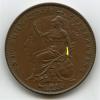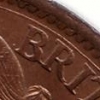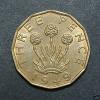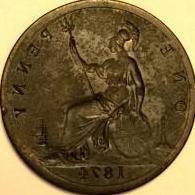Benjamin Patrick is perhaps best known as the engraver of the Perry Barr Penny token issued by William Booth, the notorious forger who was hanged in 1812. Booth was charged and convicted for forgery of bank notes and coins (the Bank Dollar, 3/- and 1/6) issued by the Bank of England.
However this is not Patrick’s only connection with forgery. In a case against the coiner William Henshall, who was transported in 1806 for counterfeiting the Bank Dollar, a Benjamin Patrick (of Phillip’s Salutation Public House in Snow Hill, Birmingham) is mentioned as engraver of counterfeit bank-note plates together with a relative(?) Washington Patrick.
I was therefore hoping that the study of the die punches used for the penny token would shed some light on the matter. The original token is unfortunately quite rare and expensive, but thanks to Bente and Paul Withers (Galata) I now have a useful photo.
Of Booths counterfeits we know the 1/6 since a hoard of these was discovered in 1956 about half a mile from Booths farm. The Birmingham Museum & Art Gallery also has a Bank Dollar which was found at the farm, only the 3/- remains unidentified.
It is possible that Booth also made counterfeits of other coins such as the Third-Guinea, however only the above coins are mentioned in his court case.
1804 BANK DOLLAR
Of the 41 counterfeit bank dollars I’ve seen so far; 20 have been cast or produced by transfer dies. The other 21 are milled from engraved dies and of these there are 3 different obverses and 5 reverses. The dies are obvious the work of two different engravers.
The letter punches used for the counterfeit Bank Dollar found at Booths farm (below) are of type I.
When the large letters of counterfeit I are compared with the large letters used for the Booth token there’s no mistake – the design is exactly the same!
All evidence therefore point to Benjamin Patrick as the engraver of both token and counterfeit. The Booth dollar is known only with the same obverse-reverse combination. There is however another obverse combined with 3 different reverses engraved by Patrick.
Obverse 1 – Nose to I of Gratia
Obverse 2 – Nose to TI of Gratia, leaves of laurel wreath almost touching E of DEI, X of Rex very close to bust
Reverse 1 – 8 of 1804 directly under 1st L of Dollar - 2nd S of Shillings points to L of England – N of Shillings points directly to 1st N of England
Reverse 2 – 8 of 1804 directly under 1st L of Dollar - 2nd S of Shillings between GL of England
Reverse 3 – 8 of 1804 to the right under 1st L of Dollar - 2nd S of Shillings between GL of England
Reverse 4 – as reverse 1 but N of Shillings to the left under 1st N of England
We know that William Henshall counterfeited the Bank Dollar but according to the article the dies was manufactured by himself – possible by some sort of transfer method? There are several counterfeit bank dollars which design are exactly the same as the genuine coins only the details are somewhat blurred like on a cast coin, perhaps some of these are the product of Henshall? Or perhaps Henshall coins are so scarce that I just haven’t seen any yet? I think the 2nd Patrick obverse, together with reverse 2-4, are likely to have been engraved at the same time as Booths (1810-11) since they are very similar in style. Henshall’s counterfeits were done in 1805 and if Patrick had been the engraver I would expect the dies to be of a somewhat different style.
So for now the coiner using the 2nd obverse remains unknown.
to be continued...
References
Peter Lane and Peter Fleig: William Henshall: Maker of NSW Holey Dollars and Dumps (Numismatic Association of Australia - NAAJ 15 2004)
Paul and Bente Withers: British copper tokens 1811-1820
The trial at large of William Booth and his associates, George Scot, the three Yates's, John Barrows and Elizabeth Childlow for Forgery, Coining etc. at the Stafford summer assizes, 1812, before Mr. Justice Le Blanc. (Gower and Smart 1812)
 Coinpublications.com
Coinpublications.com




.jpg.59f7f7c5ad8ff67a70f8db9e7dffd413.thumb.jpg.0826c31400cad2e4de5fe0a6afd6fd8b.jpg)




